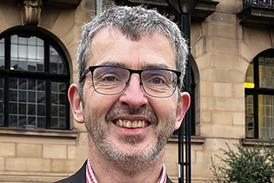Even after a year in which keeping patients out of hospital has been more of a priority than ever before, the work of community services often remains overshadowed. Claire Read reports from an HSJ webinar which explored how parity of esteem might finally be established
When Raj Jain considers his priorities as chief executive of the Northern Care Alliance group, hospital beds aren’t necessarily front and centre. He’s often thinking instead of the beds within people’s own homes.
“The strategic intention is about bringing care closer to home,” he says. “We, as a board, accepted a long time ago that was the most important thing we could do to improve the health and wellbeing of the citizens we serve.”
Yet in discussing success in meeting those aims, Mr Jain says there can be a natural tendency to speak in very hospital-centric language. “Admission avoidance means avoiding hospital discharge. Early discharge means from the hospital,” he points out.
“We’re trying to change the narrative to ensure that our community services are seen as the pinnacle. So we’re not talking about admissions avoidance, we’re talking about how we deliver care and support in the community. Getting that narrative right is hugely important to tackling this question about the parity of esteem between community services and hospitals.”
Mr Jain was speaking at a recent HSJ webinar exploring how the NHS might make the most of community healthcare services through the pandemic and beyond. At the heart of the discussion, which was supported by Malinko, there was a paradox – keeping people away from hospital has never been more important, and yet focus during the pandemic has resolutely remained on hospitals.
“I always say this is not a competition – it’s not that hospital is better than community or community better than hospital; we’re all part of one system serving our citizens,” said Crystal Oldman, chief executive of The Queen’s Nursing Institute.
“But there is something in the language that we use around acute and community because, as we all know, acute care does happen at home and yet we name some of our hospital providers acute trusts.
“That’s a subtle message that acute is where the important things happen and lives are saved. But the community actually describes where people live and where most care actually happens. 90 per cent of all clinical contacts happen in the community.”
So how can the contribution of such services be both recognised and optimised? Clara Gilfillan felt that while the pandemic may not necessarily have addressed the tendency for community services to be overshadowed, it had strengthened connections through which she and her colleagues can make a difference.
Explained Ms Gilfillan, operational lead for community nursing at Anglian Community Enterprise: “We’ve had to learn to bring other services together. We had already started to move into neighbourhoods and work closely together with other providers such as social care, mental health, GPs and our primary care networks, but certain elements of that work has been accelerated.
“During the first wave [of the pandemic] we were aware that we did have a high number of deaths in our care homes. So we met on a daily basis with teams in residential homes, discussed any outbreaks, discussed the level of support each one of these homes had, what else we could do for them.
“These meetings are still continuing, and actually if we ever come out the other side and whatever ‘the new normal’ is going to be, the meetings will still continue because they mean we can get into care homes before problems arise. So we’re offering far greater support there.”
Technology had been an important part of enabling that sort of shift, Ms Gilfillan said. “We’ve done a lot of remote working with the wider multi-disciplinary team. I think in particular our triage system has had to change dramatically, because the nature of the nursing interventions we provide is such that you can’t always rely on virtual care – you can’t dress someone’s wound over the internet.”
Róisín Reade agreed that technology has an important role to play in making the most of community services. She works as clinical lead at Malinko, which provides a clinical e-scheduling system that helps staff safely manage capacity and demand in community healthcare. But Ms Reade also emphasised that increased digitisation in itself is not enough.
“We’re fortunate enough in Malinko to work with 18 NHS providers across the country and every single organisation that we work with, we’re seeing services that are understaffed,” she reported. “We want to see our hidden heroes [in community services] getting the support that they need.”
For Mr Jain, there is a very specific aim in staffing community services. “We want our best leaders, our best clinicians, our best managers to aspire to work in those services,” he said. His hope is that the 2020s will be “the decade of community services”.
Data is crucial to proving the value of community healthcare services, panellists at a recent HSJ webinar agreed. But those speaking at the event – which was supported by Malinko – also agreed more work is needed in this area.
“We understand the importance of data in the community, but also the lack of it,” reported Raj Jain, chief executive of the Northern Care Alliance group. “So we’ve got a significant programme, working locally and with our national colleagues, to understand what datasets are going to be the most effective to invest in building.”
He said the focus is on “getting the best out of the data that we can reasonably and affordably collect, so we get the best outcomes for patients and quite frankly the best value for money”.
Crystal Oldman, chief executive of The Queen’s Nursing Institute – a charity dedicated to improving the nursing care of people in the home and community – agreed on the importance of data, but argued it would be key for clinicians to feel involved in its collection.
“Nurses and AHPs, for a very long time, have said we’re collecting all this data and we don’t know what gets done with it. I think it’s those nurses and AHPs at the point of care who can best advise around the data that’s required,” she argued.
This webinar is available to view on demand. If you had previously registered for the event, visit here to access the recording.
If you haven’t already registered, click here. Once you’ve signed up, you’ll be sent details of how to access the on demand.


























